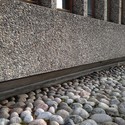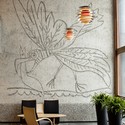architectural institutions and architects are outraged by the Norwegian government plans to demolish a unique part of the Norwegian architectural history and international. Called the Y-block for his plan in Y-shaped building in the government quarter in the center of the Norwegian capital of Oslo was designed by Norwegian architect Erling inventor and pioneer Viksjö in the 1950s with " H-block "or Highrise (1959) and was completed in 1969. the building is internationally known for the extraordinary craftsmanship of its sandblasted concrete and famous murals Pablo Picasso," fishermen "and" the Seagull. "



 12
12
the Government of the neighborhood was one of the targets of terrorist attacks in July 2011, when nine people were killed by a bomb explosion in the region. The terrorist also shot 69 people in a youth camp on the island of Utøya later the same day. The events have shaken Norway. Immediately day after the devastating terror, the current Prime Minister Jens Stoltenberg insisted that the terrorist would not change the course of the nation of democracy and openness.
Several buildings in the Oslo government district were heavily damaged. These included the two buildings of the architect Erling Viksjö the "H-Block" and "Y-block" mentioned above. Both buildings include the works of Pablo Picasso, who worked with the Norwegian sculptor Carl Nesjar on reliefs for interior and exterior surfaces, as well as the works of eminent Norwegian artists Inger Sitter, Tore Haaland Odd Tandberg and Kai Fjell.
At the time of the attack of these buildings and their works were being listed for historic preservation. After initial discussions, including a proposal to build a new government quarter on a more distant site, the Norwegian government decided to redevelop the existing area, but exactly how it should overhaul became a debate that has been present in the Norwegian media since 2011. So far, the debate has convinced the government to keep the H-block while the Y-block, with the only Picasso fresco facing the public square, to be demolished - after the withdrawal in a way the works 'integrated art "fishers" and "Seagull" that are blasted in the walls.
the planning process for the new government quarter was shockingly bad compared to other Norwegian or ambitious international projects in recent years. The Oslo process was plain, completely enclosed and lack of ambition, gaps that are now having tragic consequences for architecture and art of the Y-block building.
The debate is on the rise. Martin Braathen, architects newsletter editor Arkitektnytt concluded after a public debate last week that the Y-block must be included in the planning process. The government has no arguments to let him out, he wrote. A key argument in the debate was that the Norwegian government has never really tried to include unique aspects of the site and the Y-block in the future development plans.
When the expectations of public opinion, including the family of the architect Viksjö, and the architectural community in general is that high it should tell the government to increase ambitions for its architecture, says Hege Maria Eriksson, responsible for the architecture to the newly created Norwegian Centre for Design and architecture. Eriksson, who played a central role in the Norwegian media during the recent debate on the issue, insists: "It is not too late to decide again" and to keep the distinguished Y-block Other prominent voice. Arkitektur N include the editor, Norwegian review of architecture, and Ingerid Helsing Almaas which together with Markus Richter director of the gallery 0047, sent an open letter to all architects and planners Norwegian and international involved in the process requesting them as citizens and professionals to take the responsibility of raising the ambitions region. in short, the demand letter "more transparency and more democracy" in the current process, echoing the words of the former Labour Prime Minister Stoltenberg after the terrorist attacks.
Although the current government led by Conservative Prime Minister Erna Solberg, stubbornly insist they have finished thinking about Y-block, people are not about to give up. young architectural firms, as Eriksen & Skajaa Architects, Architects and Superunion Tyin Tegnestue also threw their weight behind the demand to include the Y-block in the known future plans.
The history of the Y-block art also has interesting international connections. The collaboration of Norwegian artist Nesjar and Spaniard Picasso inspired Picasso to insist on the use of "Norwegian sandblasted concrete" for his work on the House of Architecture in Barcelona, home of the Catalan Association of Architects . Thus, the knowledge of the Norwegian Concrete and Nesjar sculptor arrived in Barcelona in 1960 to produce a new series of murals, connecting the public square in Oslo in a public square in Barcelona.
But such stories and dreams do not care about the government of Norway, the Ministry is preparing to apply their power to demolish all that 'they want. When transforming the region and give it to future generations in a gesture of openness, democracy in empathy with these unique buildings and Picasso art seems like an impossible dream. What does this tell us about Norway today
It is not too late to ensure the future of Y-block, but the danger is obvious that the government will not even perceive the meaning of what they are about to destroy. Hope the international community will evaluate the right architecture and unique murals of higher Picasso, and make their voices heard. It's time to roar for creative thinking :! A wake for Norway
This Tuesday (December 9th), the Norwegian national broadcaster NRK will host a discussion discuss the future of the Y- Block.
Einar Bjarki Malmquist is an architect at Malmquist Arkitektur and publisher of Arkitektur N the Norwegian review of architecture in Oslo.
Posting Komentar